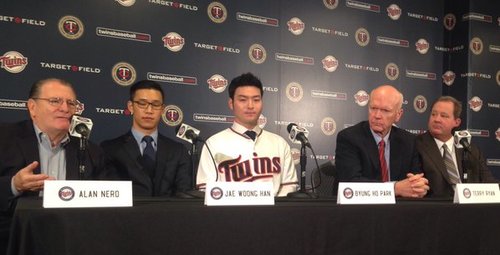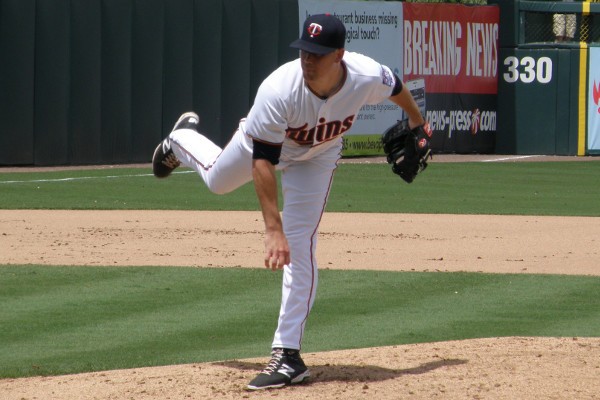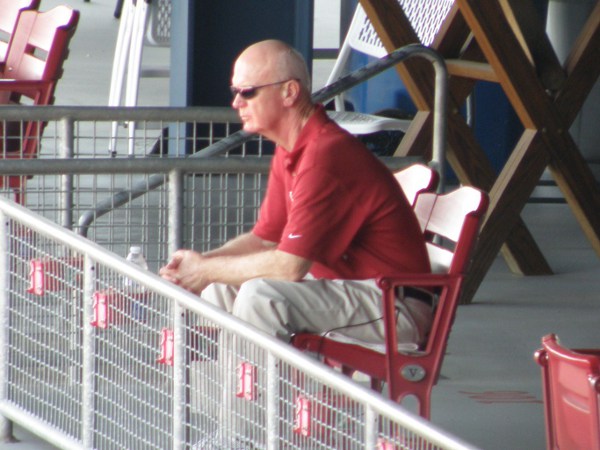
Here I am
On the road again
There I am
Up on the stage
Here I go
Playin’ star(s) again
There I go
Turn the page
It has got to be lonely being Paul Molitor these days. About the only thing separating him from the tortured Bob Seger that penned “Turn the Page” back in 1972 is that he isn’t subjected to riding a bus somewhere east of Omaha with locals at truck stops making snide remarks about his long hair.
I’m not sure what he envisioned his life would be like as the manager of the Minnesota Twins when he signed on for the gig after Ron Gardenhire was let go following the 2014 season, but I’d bet every cent I have that he wasn’t expecting this. After all, his Twins are on pace to finish with one of the worst records in Major League Baseball history. Not Twins history, not franchise history, not American League history, but in all of MLB history.
This is taking place after a season, in 2015, that many people thought saw the Twins, under Molitor in his first season as a manager at any level, take a significant step forward in terms of competitiveness.
Sure, everyone knew there were candidates for regression on the club’s roster and nobody knew what to expect of their imported Korean designated hitter, but there were also players that we felt had reasonable chances to improve their performance levels over what we saw in 2015. Even the most pessimistic among us could not have reasonably expected this to happen.
But it has happened. The Twins are 15-37 as they return home to face the Tampa Bay Rays, themselves sitting at the bottom of the American League East standings at the moment.
There has been plenty written in the Twins community about what’s gone wrong and what should be done about it. Some of the suggestions have been reasonable, many have not.
You can’t trade players for whom there is no market and you can’t really flat out release most of them, either.
Most teams won’t fire their manager and/or their general manager during the first two months of the season, especially when that manager is only in his second season at the helm and the general manager has been around forever and is credited with rebuilding a farm system that is acknowledged to be among the best in the game.
Typically, you give the guys you left spring training with a couple of months to come around before you go about making significant changes. Your options are limited in April and May, anyway, because few teams are going to be interested in adding noteworthy pieces to their rosters that early, even if you are ready to turn the page sooner than that.
But we’re into June now and while most teams still won’t be prepared to make many deals at least until later in the month, it’s time to start initiating those discussions.
It is also time to start looking at what you want your roster to look like on Opening Day 2017. If there’s a silver lining to a miserable start like this, it’s that you don’t have to wait until spring training next March to start evaluating your options. You don’t even have to wait until the traditional “September call up” portion of the season. You’ve got a full four months to look at what you’ve got before you have to make decisions about which positions you will need to fill from outside your organization during the offseason.
The Twins are likely to lose over 100 games this season. It could be more. It could be a few less, but not a lot less.
It’s time to turn the page.
Listen, I like Trevor Plouffe. He has, in my view, turned himself into a more-than-adequate third baseman after nearly playing himself out of baseball at shortstop. He also hits enough that there’s nothing wrong with him being a regular in a Major League lineup.
I like Brian Dozier even more. He came to Cedar Rapids in January, 2013, with the first Twins Caravan after the Twins announced they would be affiliating with the local Kernels Class A team and did a great job on the dais. With the personality he showed that night, it came as no surprise to me that he eventually became a fan favorite in the Twin Cities. Like Plouffe, he turned out not to be the answer for the Twins at shortstop, but he transitioned to second base where he has done an excellent job.
When Joe Nathan departed, many of us were nervous about whether the Twins would find someone capable of holding down the closer role out of the bullpen. Enter Glen Perkins and the problem was solved.
Joe Mauer’s situation would command a full article itself, but his contract and no-trade rights make it a waste of time to even discuss his future with the team for the next couple of seasons.
These players, along with a few others perhaps, have had good rides as members of the Twins and they have earned every bit of fan loyalty they get. But the hard truth is that few, if any, of them are going to be part of the next run of winning seasons at Target Field.
Already this season, injuries have created opportunities to look at some young players. In most cases, those opportunities were wasted as players like Jorge Polanco and Max Kepler rode the pine during their time filling in for banged up regulars.

Maybe “playin’ stars again” was defensible early in the season when you were still trying to make something of your season, but no longer. It’s time to turn the page.
As Ted over at Off the Baggy pointed out this week, with Kepler being promoted again (this time to fill in for the injured Miguel Sano), it’s time to plug Kepler and the also-recently-recalled Byron Buxton into the lineup and let them run.
Sano’s hamstring will eventually heal and he’ll return. I find myself agreeing with Howard Sinker of the Star-Tribune who tweeted earlier this week, “Friends, I was less skeptical on it than most of you, but it’s time for the Sano-in-right field thing to end. Make something work, #MNTwins.”
I really had no issue with putting Sano in the outfield. He’s athletic enough that he should be able to play a passable right field and he has improved out there. But I’ve pulled a hamstring before and I know that, once you do that, it’s pretty easy to do it again. I don’t think putting him back out there when he comes back makes a lot of sense when it’s pretty obvious that it is not going to be his position long-term (and by long-term, we are probably now including 2017).
The Twins need to decide where they envision Sano fitting in. Wherever that is, whether it’s third base, first base or simply as their full-time designated hitter, I would just plug him in there when he gets back and move on to the next decision.
Bouncing Buxton, Kepler and Polanco up and down between Minneapolis and Rochester should end. Buxton is your center fielder, Kepler is in a corner and Polanco is in the middle of your infield somewhere.
I’ve seen others opine that Byung Ho Park should be sent down to Rochester, perhaps to make room for Sano when he comes back. I disagree, unless the Twins are prematurely giving up on him. He will hit AAA pitching, just as he hit Korean pro ball pitching. He needs to learn to hit MLB pitching and if the Twins plan on keeping him, he should stay in the Twins’ lineup until he proves that he can (or can’t).
I don’t know if Oswaldo Arcia will be in the Twins outfield for the next few years, but I know Danny Santana and Eduardo Nunez won’t, so Arcia should get more time out there with Buxton and Kepler (unless the Twins decide someone like Adam Bret Walker should get a long look).
The same situation exists behind the plate. Kurt Suzuki’s time with the Twins is nearing an end. I don’t know who will take over, but now is the time for the Twins to get extended looks at their internal candidates.
You could make similar cases for an overhaul of the pitching staff, but I’d be more patient with promoting the young pitchers, unless you get good offers for some of your existing staff members. I just see less urgency there.
Finally, there’s the Molitor question and that is tethered to the Terry Ryan question. Will either, or both, be back in 2017 and beyond?
Molitor will be entering the final year of his existing contract in 2017. Typically, no manager likes being a “lame duck” manager. He wants an extension in place before the start of the final year of his deal or he risks losing his clubhouse as players begin to tune his message out as they assume he won’t be around long.
Say what you will about the infamous Jim Pohlad patience with his front office, but I think Ryan would have a tough time convincing even Pohlad that Molitor should be rewarded for his work in 2016 with an extension.
Of course, that assumes that Ryan will even be around to make that pitch to Pohlad.
It’s almost impossible for me to envision Pohlad announcing publicly that he has dismissed Terry Ryan. It is not difficult at all, however, for me to envision an announcement that Terry Ryan has decided that, as the person responsible for assembling the roster, he is ultimately responsible for the results and that he is holding himself accountable and stepping down as GM of the Twins.
That public announcement would be identical, by the way, regardless of whether the decision truly is Ryan’s or whether Pohlad makes the decision that it’s time for a change. If you’re looking for public executions, you’re going to be disappointed.
If Ryan is contemplating that this may be his last season in the GM chair, he’s not likely to make a managerial change during the season. If he’s planning on being around a while longer, then yes, he could (and should) be considering whether there’s someone besides Molitor in the organization that he now believes would be a better fit to manage the new group of young players coming up.
If indeed Ryan is replaced as the General Manager, it would be much more likely that Molitor also would be replaced following the end of this season. The new GM would want, and should get, his own man to run the team he assembles.
Whether these changes in management are made or not should depend solely on whether ownership envisions the current leadership being the right people to guide the team through the next era of competitiveness.
Regardless, it is time to begin turning the page. Some of the changes can wait as things play out over the rest of this season and the subsequent offseason, but seeing names like Buxton, Kepler and Polanco consistently in the Twins’ lineup should start now.

















